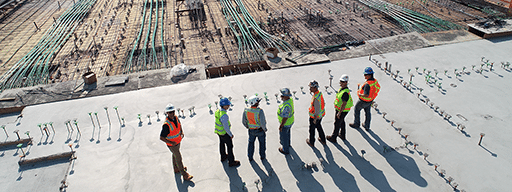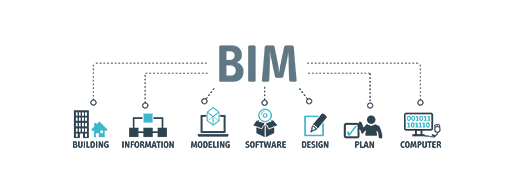Using Big Data in Real Estate To Reduce Risk
Using big data has helped all kinds of industries around the world to operate more efficiently – including real estate. Being able to access and process large pools of information can allow you to work more efficiently, as well as reduce harmful risks along the way. This can save valuable time and money.

In real estate, there can be plenty of risks involved. Due to the scale and intensity of certain real estate projects, the cost of risk can be catastrophic. This is why data analytics and smart processing of information needs to be applied.
Using specialized software and taking a BIM approach towards real estate projects can help to smooth out these risks. This creates a far more successful outcome – not to mention a much more stress-free process.
Data in Real Estate: The Main Internal Risks & How To Reduce Them
Real estate projects pose plenty of risks. Falling victim to these risks can turn into seriously time-consuming, expensive, and stressful situations. Here are some of the main internal risks involved in real estate projects. These are risks that can be reduced through the smart use of data and BIM.
1. Unreasonable Schedules
Implementing an unreasonably tight schedule is something that can severely affect any real estate project. The kind of time frame that you put in place needs to be accurate. Otherwise, all kinds of roadblocks and bottlenecks can occur.
Having to extend the construction process past the set schedule can lead to inflated costs. This messes up the initial budget and can lead to a very unhappy real estate owner.
Running a project with an unreasonable schedule could also result in work that is rushed. The risks here could involve work that is delivered at a low standard – leading to the need for rework. This could be a very expensive and time-consuming process.
Setting a tight time frame for a real estate project could also create bottlenecks or buffers in the work process. This would be due to insufficient planning and work scheduling – creating a situation that compromises the efficiency of work.
The internal risk of schedule planning can be optimized by using data and BIM. This would allow you to store specific construction schedules in the model and run simulations on the work process during the construction phase.
The use of data can also optimize the planning phase here. Planning is an interdisciplinary process, which means that there can be a lot going on at any given time. Therefore, it is necessary to schedule who needs to deliver what information in order not to block other planning parties.
Having access to this data can create a more realistic understanding of the kind of processes required in a project. This will all help to estimate a more accurate and realistic time frame and helps to produce a more efficient work structure. With bimspot, you can also define your goals and track project progress so that you can spot any irregularities or delays before they become too costly.
2. Changing Design
When you initiate real estate plans, changing them at a later stage is not ideal. Changing design often comes from a change of circumstances in a project – for example, a hotel project may be changed into a residential property.
Using BIM can help to better tackle problems in complex situations like this. It also allows you to better compare alternative solutions so that you can proceed in the best way possible.
Having incorrect or problematic design put into place will mean that design changes are needed along the way. This can be an expensive process and it will also add an unwanted delay to the construction schedule. Redesign needs to be avoided at all costs.
Using BIM allows for a high planning quality during the early stages. You get a more realistic overview of the planning process and will have more detailed and accurate data to work with. Using BIM and data also means that you will get to constantly monitor the project’s key performance indicators (KPIs). This will help to keep the project on the right path (and avoid unwanted redesign).
Some other ways that BIM can help to produce more accurate designs include doing visual checks through the model viewer, as well as being able to do building code checks. This will ensure compliance with local building regulations when construction kicks off – resulting in a process that is free from any avoidable hiccups.

3. Lack Of Scope Definition
Risk in real estate often comes from a lack of planning, or poor planning methods being used. When undertaking a new project, covering every little detail of the process during planning is essential. A lack of proper scope definition can cause many unwanted errors along the way.
Always make sure to clearly define your requirements at the very beginning of the project. Understand exactly what you want to archive (eg. net area for certain usages). You will also need to define the quality requirements for the planners, and detail exactly who is responsible for what. Understanding the scope of the project and the kind of jobs and details needed for its success will put you on the right track for a successful operation.
Having access to the full scale of data that is relevant to each project will help planners to map out scope definition more accurately. BIM tools like bimspot can be used to help real estate planners understand the many different processes and jobs required for the project.
4. Documents Not Issued
As mentioned above, risk will be present in scenarios where there isn’t sufficient planning. A large area for mistakes in these situations is when certain documents are not issued. This is relevant in the design and planning process. Clear documentation of the process, and a widespread understanding of the project, is necessary to reduce risk along the way.
In order to reduce risk here, project planners should set up a data-driven planning process. This should define exactly who has to deliver what and by when. Using data and sophisticated BIM tools like bimspot will help to monitor and understand this process in real-time.
It allows you to overcome the physical file-based approach to share and store information to a database-driven model. Access becomes easier and files are kept safer. This will ensure that everyone has access to the information they need and know their role in the project.
Using Data in Real Estate To Reduce Risks For Owners
Owning real estate can be a costly business if the many risks involved are not dealt with correctly. The risks outlined above can cause all kinds of impactful issues. Besides just being expensive, they can waste time and various other precious resources involved in these projects. Using data offers a great solution to combat these risks – helping owners to make informed decisions.
There is always the risk of pricing and investment in real estate. Being able to lean on data analysis can help owners to understand property market values.
Then there is the risk of compliance. Acting negligently here can result in reporting wrong information to shareholders and regulatory bodies – a major risk. By using well-managed data analytics, this risk can be reduced.
Making use of BIM allows owners to access the necessary valuable information around real estate here. This can completely optimize the planning process with all of the information available. It also helps owners to manage their properties better. Using data effectively is key to reducing risk in real estate.

Minimising Risks In The Design Sphere
The early design phase is an area that can offer plenty of risks. Minimising risk during design can help to prevent significant harm later on.
Running with a defective design can be a major problem. Often, this is only something that is discovered later on in the development phase, causing an unwanted and inconvenient rework of the design. BIM can help here by allowing for domestic and interdisciplinary model checks (like clash detection). This will help to identify any problems early on in the design process so that you can avoid costly delays and redesign work.
Having a deficiency in drawings is another design risk. Taking BIM level 2 or 3 approaches here can help as they are model-centric. This minimises the risks involved when just using 2D planning, making sure that every element of the building is covered.
As mentioned earlier, documents not being issued is a major risk in the design sphere of a real estate project. Setting up a data-driven planning process and using BIM can reduce the risk here as all tasks and processes become clearly defined.
Using bimspot offers the full range of information needed for a successful design sphere. The advanced Model Viewer makes the planning phase run seamlessly through collaboration. You and your team can easily identify and solve issues to optimise your real estate project. Minimising risk during this phase is crucial as it will allow for a smooth process that follows after.
Final Thoughts about Data in Real Estate
Data analytics is not always the first topic on the minds of real estate owners. However, using large pools of relevant information can be an essential ingredient to successful project implementation and management. Data is everywhere, and, if used correctly, it can help to prevent all kinds of issues that would otherwise arise.
Risk in real estate is a serious concern. This is because mistakes can be costly, and result in major consequences. The only way to make sure that things run smoothly is by harnessing all available data and using it to avoid risks that would otherwise occur.
By utilising bimspot, you can easily minimise these unwanted risks and avoid costly delays. It will ensure that your real estate projects run smoothly by ensuring better, more accurate planning and modelling right from the start.
Visit BIM News and Trend for all the related blog articles
You might also be interested in…
BIM Basics and Implementation
How does IFC (Industry Foundation Classes) work?
The IFC standard has been developed by BuildingSmart to make a global standardised tool that could support and monitor construction progress and life cycle of buildings

Bálint Bende



